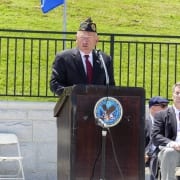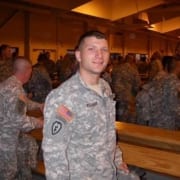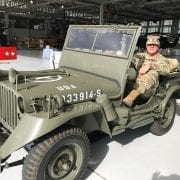Recent Military Aviation Accidents Take One of Our Own
By Anna Selman, Programs and Public Relations Coordinator
On April 3, 2018, Marine Captain Samuel Schultz passed away in during a military aviation training accident in Southern California. He was 28 years old. A born and raised Philadelphia native, Capt. Schultz was described as “fearless” and “a driven individual”. He joined the military 6 years ago – following in the footsteps of his family with that same fearless attitude.
His funeral was held in his hometown of Philadelphia, PA on April 15, 2018, and the Jewish War Veterans of the U.S.A. was there. According to Post Commander Bruce Kanis, “1,100 people were at the Funeral Chapel ranging from a 4 Star USMC General Magnus to Admirals to Lance Corporals to many of his friends from both coasts. We (JWV) provided a full JWV service along with another Gold Star Memorial Plaque from Post 215 to the family. At the grave, I presented a full Veteran Detail of JWV, American Legion, Marine Leatherneck, and Warrior Watch members who gave proper salute and honors during the service in conjunction with a full Marine Honor and Firing Detail.”
However, questions on why and how this happened has overwhelmed military leadership. Since training season began in the spring, at least 27 US service members have died in noncombat-related crashes of military aircraft and more injured. It has plagued all the services – Army, Marines, Navy and Air Force alike. So, the question is why is this happening and why now?
As in all military accidents, investigations into each individual accident started with each crash. However, each individual investigation will not look into the magnitude of the situation. As I am typing this, a proposal to create an independent national commission on military aviation safety, offered by HASC Ranking Member Adam Smith just passed the committee by a unanimous voice vote – meaning there will be a Congressional review of all military aviation accidents from 2013 to 2018.
Why 2013? That is because 2013 is the year that the Sequestration started to ramp up. According to a report by the Military Times, the Sequestration disproportionately affected maintenance and operations budgets – cutting the budget by 1 trillion dollars during its effect. The military decided to cut flight hours, maintenance on heavy aircraft and to delay replacing old equipment. Military personnel, such as ground maintenance crews, were let go, and we are now starting to see the effects of those decisions.
However, operational requirements did not change from 2012 to 2013, which means that pilots were flying the same amount of missions with a smaller amount of aircraft and a smaller group of pilots and maintenance crews. In 2016, the problem started show itself. The Air Force realized that it was facing a shortage of 700 fighter pilots and a shortage of 2,500 ground-maintenance workers.
The aircraft that Captain Schultz flew on April 3rd was a CH-53E Super Stallion helicopter. The Marine Corps currently has 143 CH-53Es in its inventory, despite having a requirement for 200 heavy-lift helicopters. On average, only 37 percent of them are flyable at any given time. Difficulties in keeping the aircraft airworthy, in turn making it hard for pilots to get in adequate flying hours to remain proficient in the various tasks the helicopter performs, have undoubtedly contributed to a string of deadly accidents with the type.
In turn, we have seen deadly accidents coming from stateside training exercise increase the past couple of years. We know service members sign up for the military knowing full well that they might die in combat, but what they do not sign up for is dying in a training accident. The best way we can honor Captain Schultz’s memory is to make sure that our service members have proper equipment and training before we send them out to the field.
Volume 72. Number 2. Summer 2018











Leave a Reply
Want to join the discussion?Feel free to contribute!